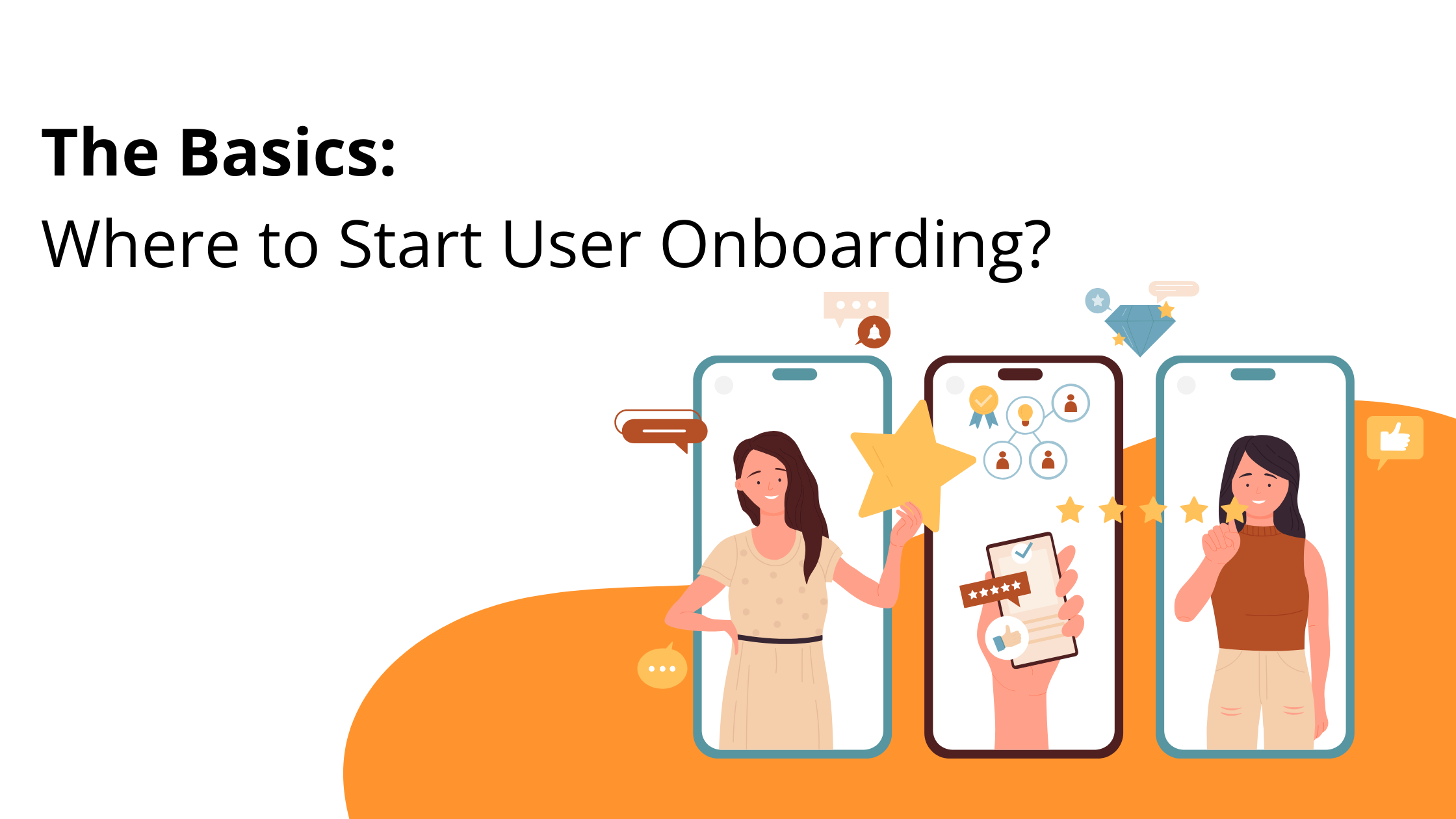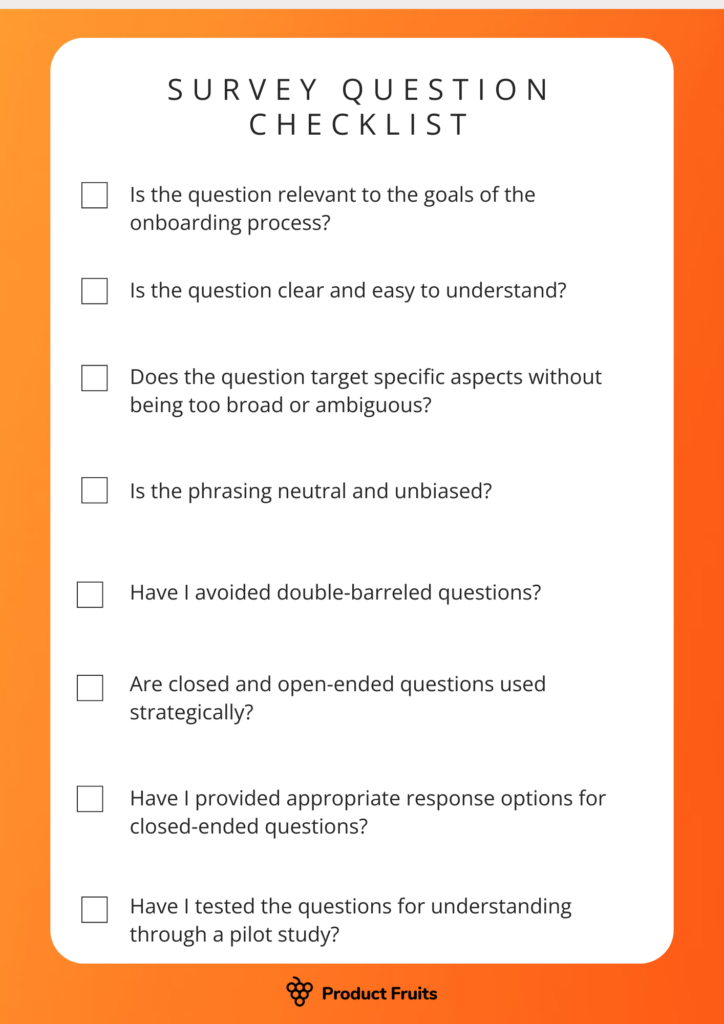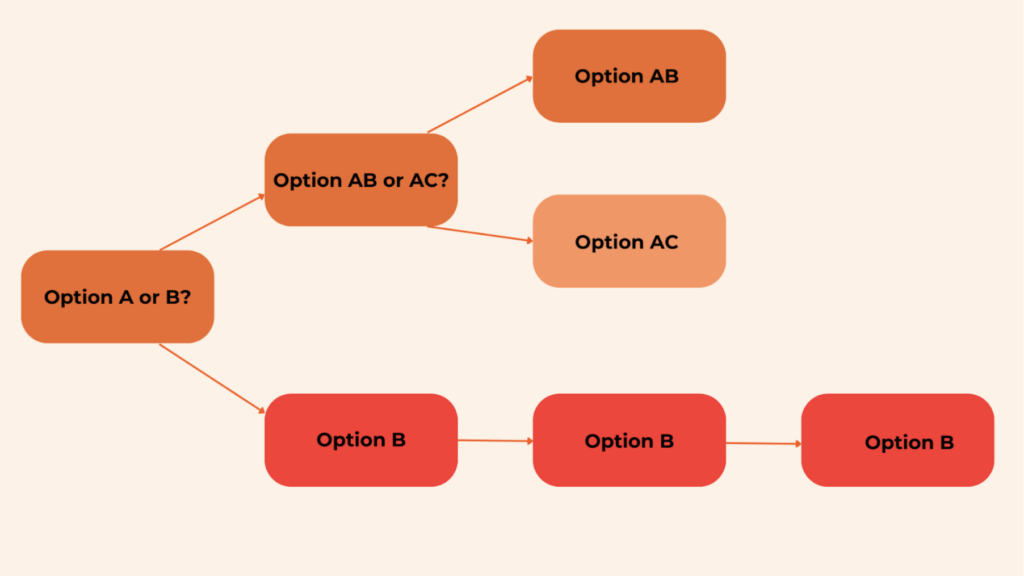
“Wow, that’s a great question”, has that thought ever popped in your head while in a conversation with somebody? It’s that feeling you get when asked a question that is thoughtful, relevant, and shows that the other person has paid close attention to your words and thoughts.
The right questions provoke thought, and make you feel heard.
And, the right survey questions will make a big impact on your product development success and overall user onboarding experience.
In this article, we’ll cover what good survey questions look like (we include a checklist template for your next survey), and cover different types of good survey questions depending on your goals.
If you’re in a hurry to send in-app surveys, here’s your quick-start free trial link. 👈
A good survey question is easy to understand and asks users questions that form part of an overall strategy to improve the user experience.
Here are some key attributes of a good survey question:
We’ve created a checklist below to help you go through the list of must-haves to make sure your survey questions are a success.
Here’s a cheat sheet for your next survey:

The more concise your questions, the more likely you are to have a response that provides actionable insights.
We’ve broken down helpful and good survey questions into categories and goals to help you choose the most relevant templates.
Profile information gives you direct information about each user, their goals, pain points, and most importantly– expectations. Insight into their profile allows for a personalized and customized user onboarding experience.
Goal(s) for these survey questions:
Here’s a list of profile information to include:

Product adoption plays a big role in customer loyalty, engagement, and profit in the long run. The more your users adopt a product, the more likely they become loyal and paying customers.
Goal(s) for these survey questions:
Product adoption questions include:
Understanding the drivers behind adoption decisions provides insights into the perceived value proposition of the SaaS solution, helping vendors better understand customer needs and preferences
Assessing the breadth of adoption within the organization provides insights into the product’s scalability and impact, indicating its potential to become a widespread solution across the organization
Evaluating satisfaction with the onboarding process helps identify areas for improvement in user training and setup, and reduce barriers to adoption
Understanding how the product addresses organizational pain points demonstrates its value proposition and ROI, reinforcing adoption by showcasing its ability to solve critical business problems
5. Have you integrated [product name] with other tools or systems used within your organization? If yes, please specify.
Assessing integration levels indicates the product’s compatibility with existing infrastructure, demonstrating its ability to seamlessly fit into the organization’s workflow and ecosystem
6. What additional features or functionalities would you like to see in [product name] to better meet your organization’s needs?
Soliciting feedback to align customer requirements with future product development
7. Have you encountered any challenges or obstacles in the adoption process of [product name]? If yes, please specify.
Identifying adoption barriers helps address issues such as technical challenges, training gaps, or organizational resistance, facilitating smoother adoption, and maximizing product value
8. How do you measure the success or impact of [product name] within your organization?
Understanding how the organization measures success with the product provides insights into its perceived value and ROI, helping vendors demonstrate the product’s impact on key business metrics. Which can be used as highlight data in newsletters or homepages
9. What resources or support would you find most beneficial in driving further adoption and maximizing the value of [product name]?
Understanding customer support and resource needs helps vendors tailor customer success initiatives to address adoption challenges and drive long-term satisfaction and retention

New features always come with a risk — either they become a success or flop. For success, users need to understand how a new feature works– and the value it brings.
Goal(s) for feature adoption survey questions:
Feature adoption questions include:
This measurement gives you an idea of how many users found value in a new feature, and whether it was announced and onboarded properly
You’re able to understand how much value and impact a new feature has on the overall workflow and value of your product, as well as if it has solved pain points for users
Understand roadblocks to user implementation to improve onboarding flows and educational content around a new feature, like for example, adding a webinar or video tutorial
Understand if a new feature has solved the pain point of your users, or if it requires further iterations
Assessing user advocacy indicates satisfaction levels and perceived usefulness of the feature. Understanding reasons for recommendations, or lack, provides valuable feedback for marketing and product development efforts
Gives insight into onboarding material that needs to be created for better product adoption
Quantifying the benefits of the feature in terms of time, cost, or resource savings provides tangible evidence of its value
Understand which features provide value in the long term as market and industry change and grow
Understand if webinars would be helpful to the feature adoption and to highlight the value of a platform
Increase product usage understanding and helps with messaging framework for the marketing and sales team
Understand and solve any roadblocks in the development, integration, or onboarding of each new feature

Product satisfaction has an impact on user churn and retention. When your product satisfies the goal and needs of your user, it becomes valuable to their tech stack, and therefore, less likely to churn
Goal(s):
Questions to help understand product satisfaction:
Understanding the frequency of feature usage provides insights into its importance and integration into the user’s workflow. Higher usage frequency typically correlates with higher satisfaction and perceived value of the feature.
This will help you identify what onboarding flows need improvement or more onboarding content
Understanding the perceived benefits of the feature helps assess its value proposition and impact on user productivity or goal achievement. It provides qualitative insights into the feature’s utility and relevance to users’ needs.
Assessing user advocacy indicates satisfaction levels and the perceived usefulness of the feature. Understanding reasons for recommendations or lack thereof provides valuable feedback for marketing and product development efforts.
Soliciting user feedback on desired enhancements guides future feature development, making sure of alignment with user needs and preferences. It helps prioritize feature roadmap decisions based on user input
Identifying bugs or glitches helps address technical issues promptly, improving user experience and satisfaction. It facilitates bug resolution and quality assurance processes for successful feature usage
Assessing the ease of learning indicates the effectiveness of onboarding and training materials. Understanding user perceptions of ease of use helps optimize user education processes for smoother feature adoption
This question helps evaluate the impact of the feature on the overall user experience. It provides insights into the feature’s role in enhancing or detracting from the perceived value of the product/service
Assessing user interest in beta programs indicates engagement levels and willingness to contribute to product development. It helps gauge user involvement in shaping future feature releases
Soliciting feedback on integration helps create seamless user experiences across different features and functionalities. It provides insights into user expectations for cohesive product experiences
Understanding the impact on productivity or performance provides tangible evidence of the feature’s value proposition. It helps quantify the benefits of the feature in terms of efficiency and effectiveness.
Assessing perceived value helps evaluate the feature’s return on investment from the user’s perspective. It provides insights into pricing perceptions and potential adjustments needed to align with user expectations

Each survey comes with different formats and approaches that will gather more actionable results.
Here are some tips to help you receive more in-app survey responses from users.
An eye-catching and creative survey design that complements survey questions goes a long way in helping users answer questions thoroughly and effectively.
The choice of survey formats, colors, and media added can increase question understanding and make the feedback process more enjoyable00 and thus more reliable– for users.
👀: 11 SaaS Survey Design Best Practices You Need To Follow in 2024
Each question needs to directly relate to the goals of your onboarding process. Think about what the goal of the survey is, and what information you need from users.
That will guide you to create questions that serve a purpose and will give you the insight you need to take strategic action.
For example, if you want to improve conversion rates during a free trial, opt to ask users about their onboarding journey and experience, over asking them to share information about their current usage and habits.
Use simple language, avoid jargon, and be straight to the point to avoid misinterpretation or confusion.
For example, instead of “We take great pride in our welcome drinks and want to know if you enjoyed them”, opt for “ Did you enjoy the welcome drinks”. Answers will depend on the clarity of a question. Don’t leave room for personal interpretation, as data will be skewed as a result.
Use survey branching — also known as survey logic– to customize survey questions based on previous answers.
Survey branching makes questions asked more relevant, by cutting unnecessary questions based on information already provided.
This allows you to collect more personalized and granular data from users.
Here’s a graph to help you visualize survey branching:

Use neutral and unbiased language and phrasing to prevent leading respondents to a particular answer.
Avoid loaded language or assumptions that could influence their responses. For example, instead of asking users; “Did you think that the educational product tours were more helpful than onboarding checklists”, ask them “Do you prefer product tours or checklists?”.
Only address one issue per question, that will help to finetune pain points and challenges with more accuracy.
Even if it’s tempting to include two different issues that might be related, you’ll have more accurate answers when you stick to one question per issue.
Use close-ended questions when you need quantifiable data. For example, to get a statistic on the amount of users that agree, “Do you use segmentation during user onboarding? Yes or No”.
While, you’d use open-ended questions to find opinions and nights. For example, “ What do you use user segmentation for?”
Provide appropriate response options for closed-ended questions, so they cover all possible answers without overlapping or excluding choices.
Consider if a scale or multiple-choice will give you enough data to create action, or if you need to opt for an open question for more data.
Always conduct a small pilot study to make sure the order, and questions make sense, and are easy to understand.
You need to check for branching logic, user understanding, and if the survey gets the answers you need for strategy improvement.
Once you have feedback and data from your users, it’s time to change your onboarding flow to meet their expectations.
Product Fruits offers the choice to either start with our wide selection of templates or begin a survey from the ground up.
Both pre-made and original surveys can be completely tailored to seamlessly integrate with your platform design. Additionally, our user onboarding tool is the only one that includes survey branching.

This means, not only is your data more relevant, but you can tailor the survey to fit your needs using different survey questions, colors, media, and custom rules.
And…
Product Fruits offers the whole range of features for onboarding. You can include welcome tours, checklists, hints, and help centers, all tailored for each user.
No coding is required — just simply drag and drop.
Create your own surveys today, and try Product Fruits for free.